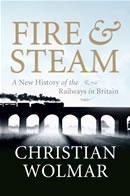 Fire & Steam: a new history of the railways in Britain, Christian Wolmar. Atlantic Books, London (2007). 384pp., £19.99, ISBN: 978 1843546290
Fire & Steam: a new history of the railways in Britain, Christian Wolmar. Atlantic Books, London (2007). 384pp., £19.99, ISBN: 978 1843546290
With Fire & Steam Christian Wolmar has augmented his previous rail-related work in much the same way as The Subterranean Railway (Wolmar, 2006) added to his earlier analysis of the London Underground: a swingeing critique of a recent episode of government policy (privatisation in the case of the railways, the Public Private Partnership – a form of privatisation – in the case of the Tube) is followed up by a gloriously upbeat history of the mode. In The Subterranean Railway, Wolmar begins by making reference to childhood memories of his object of study and goes on to revel in the achievements of those who built and ran it; that book and Fire & Steam also share this similarity. As might be expected, though, the work is none the poorer for this – while Wolmar wears on his sleeve a heartfelt fondness for Britain’s railways, he has gone to great lengths to put together a thoroughly researched, highly informative and eminently readable book which does not lack critical insight but instead directs it at those responsible for hindering the development of the iron roads in a sensible manner (politicians, of course, attract his opprobrium but also railway people from time to time).
Wolmar sets out ‘‘to put the history of the railways encompassing both their construction and their social impact in one easy-to-read volume” (p. xi). Underpinning his aim is the observation that few writers have attempted this before, certainly not recently, and that this is a shame because the ‘‘railways constitute a fantastic story which has often been told only by those obsessed with particular aspects of the system, individual lines or even specific types of locomotives” (pp. xi–xii). The clear implication here is that while O.S. Nock and his ilk have done a fantastic job chronicling and analysing much of the minutiae, a broader sweep is necessary if the impact of the railways on the functioning of the modern British economy and society (and, increasingly, environment) is to be brought to the widest possible audience. This is probably fair – I suspect Wolmar sees Jack Simmons’s excellent volumes as a little too academic – but rather defensively he starts by covering his back with regard to the book’s lack of comprehensiveness. This is of course inevitable in a book of this nature, although it almost seems his intention was to cut reviewers – especially those obsessed by a particular aspect of the system – off at the pass before they offered an undulyharsh review on the basis of their favourite piece of detail having been omitted.
For those of us interested in broader issues, Fire & Steam does an excellent job. Most strikingly, the book brings to life the characters entwined with the railways’ development to reveal a complex relationship between trains and those they serve. Key themes are entrepreneur- ialism, greed, socio-economic change, the fractious and of- ten damaging relationship between the railways and the state and, of particular interest to readers of this journal, geography. Railway geography has progressed through clearly identifiable phases. First, the existing geography of the landscape – human and physical – dictated where the railways went and why. Excepting Louis XIV’s ostenta- tious back-garden toy railway (you will have to read the book to believe it), the earliest railways often ran from within mines to the nearest waterway. What Wolmar re- gards as the first ‘proper’ railway – the Liverpool to Manchester, on account of its being double tracked and running between two cities – was built primarily to link Lancashire’s mills with its main seaport (the canals were expensive and slow). The routes of numerous railway lines were dictated by physical obstacles or a mixture of physical obstacles and social factors such as the need to keep con- struction costs down (e.g. Dartmoor in the case of the Exe- ter to Plymouth line), but on flatter land railway entrepreneurs were often able – sometimes after quite a protracted and expensive negotiating process – to buy off protesting land owners and prevent the lines from making too many unwanted detours. The attitude of many of these landowners is splendidly summed up by the surgeon Sir Astley Cooper, whose horror at the arrival of the railways in his backyard prompted him to exclaim them ‘‘‘preposter- ous in the extreme’… Why, he concluded, ‘if this sort of thing be permitted to go on, you will in a very few years de- stroy the noblesse”’ (p. 63).
Quickly, though, it is possible to identify a new phase in railway geography. Whereas the geography of railway lines was at first determined solely by the need – or in some cases in the height of railway mania the perceived need – to link goods and people to existing markets, once constructed the railways began themselves to influence the geography of the country in a range of ways. First, the ensuing space- time convergence although spatially uneven changed Brit- ain’s economic geography; some businesses failed, such as those dependent on stagecoach operations, while others thrived, for instance inland fish and chip shops, which could now get fresh fish delivered regularly. Social geography was also affected (e.g. time was standardised across the country rather than varying from one town to another), as was urban geography (railway entrepreneurs could buy up cheap country land, build a railway into it and sell houses there, in the process creating a ‘suburban idyll’ as exempli- fied by ‘Metro-Land’ in Buckinghamshire). In another, more recent phase of railway geography, trains have been unable to compete with road transport in terms of flexibil- ity, and the geography of both the rail network (which contracted) and broader patterns of settlement and socio- economic activity (which became more diverse) have of course changed to reflect this.
In his final chapter, ‘The Future is Rail’, Wolmar sug- gests that the ‘‘railways have turned full circle” (p. 300) in the sense that they are now back in private hands after half a century of nationalisation. Undoubtedly, though, they have turned full circle in at least one other important way: the side-effects of ‘car culture’ – increased pollution and congestion, the relative danger of roads, the health im- pact of automobility and so on – have once again placed train travel (along with other initiatives such as ‘soft’ mea- sures) at the heart of the transport agenda. As if to re- emphasise the difficult relationship between the railways and the state in this country, British politicians are reluc- tant to invest in enhancing the capacity of the network but thankfully, as Wolmar points out, this is not character- istic of other governments. New urban rail systems and high speed lines are springing up across Europe (perhaps most impressively, Spain is currently building a 7200 km network of high speed lines) and also in countries like Chi- na, South Korea and even the USA (witness the transit plans in Denver which involve the construction of several new commuter lines funded by increased sales tax).
Wolmar ends his book in the same upbeat tone he main- tains more or less throughout the text. The book is a cele- bration of the history of a mode of transport in Britain in which he – and many others – sees a host of virtues which are often overlooked and which have not been reported in this manner for some time. The book is not, and does not claim to be, strictly academic, but it will surely be used as source material for many academic studies not least be- cause, crucially, it provides a ‘big picture’ introduction to the major developments in, and socio-economic impacts of, Britain’s railways. It will be best read alongside other railway and broader social and economic histories, but it will pique the interest of students and could play a much- needed role in locating transport on the radar screens of other human geographers (and social scientists) who all- too-often overlook its significance in their analyses.
Reference
Wolmar C., 2006. The Subterranean Railway: How the London Underground was Built and How It Changed the City Forever. Atlantic Books, London.
Jon Shaw, School of Geography, University of Plymouth, Plymouth PL4 8AA, UK
Tel.: +44 (0) 1752 585963
E-mail address: jon.shaw@plymouth.ac.uk
